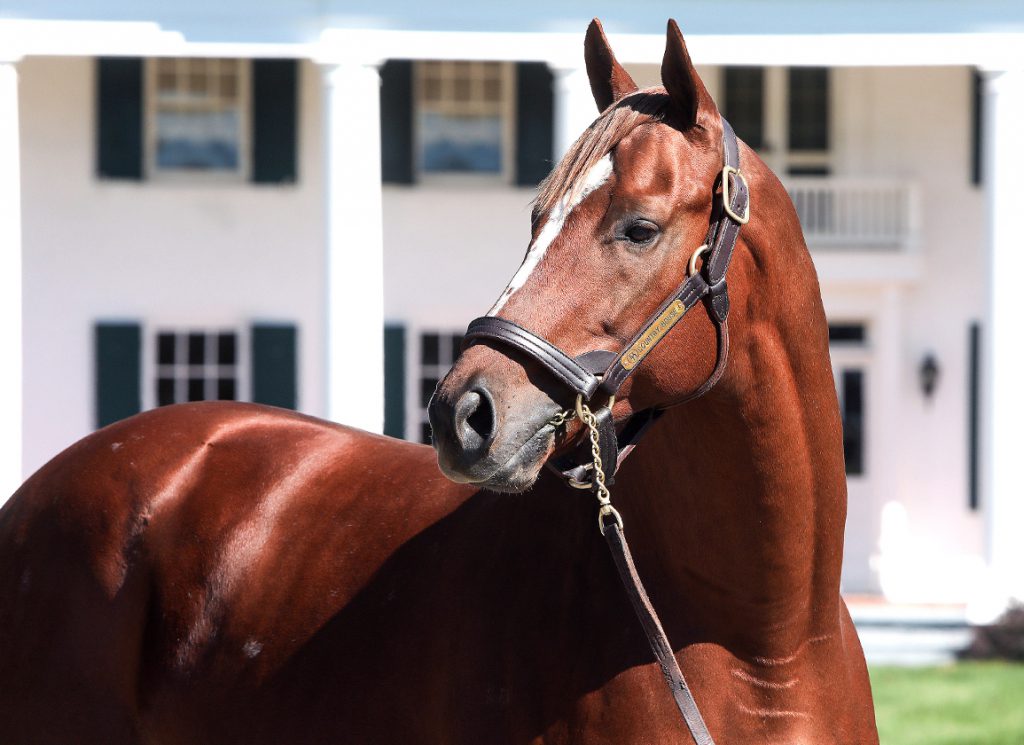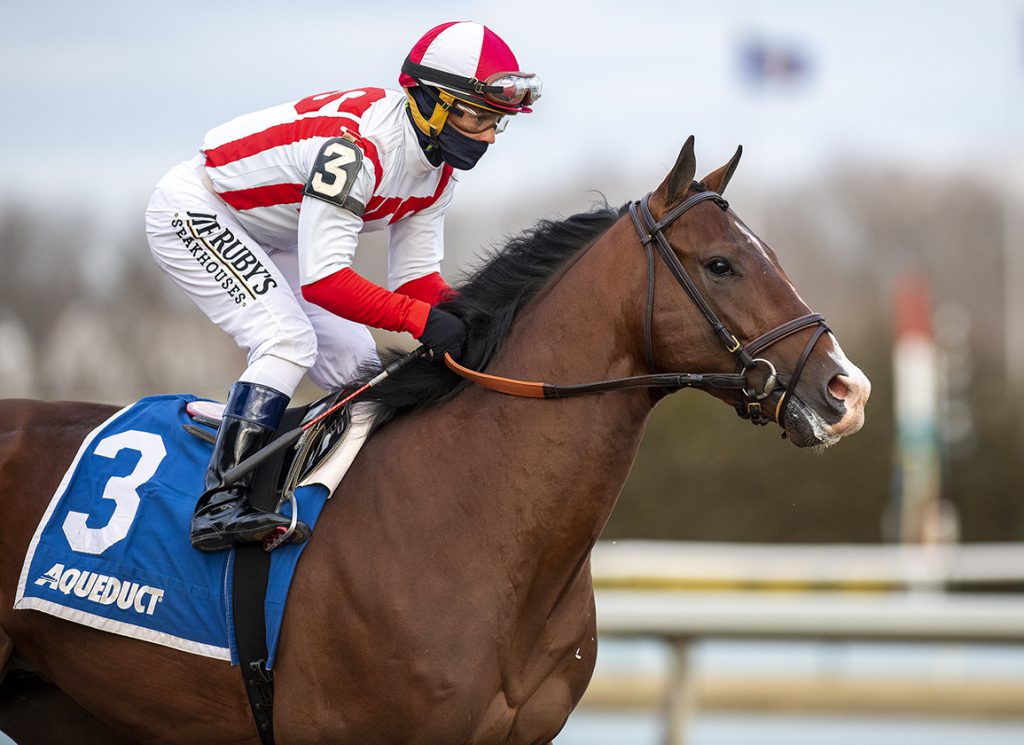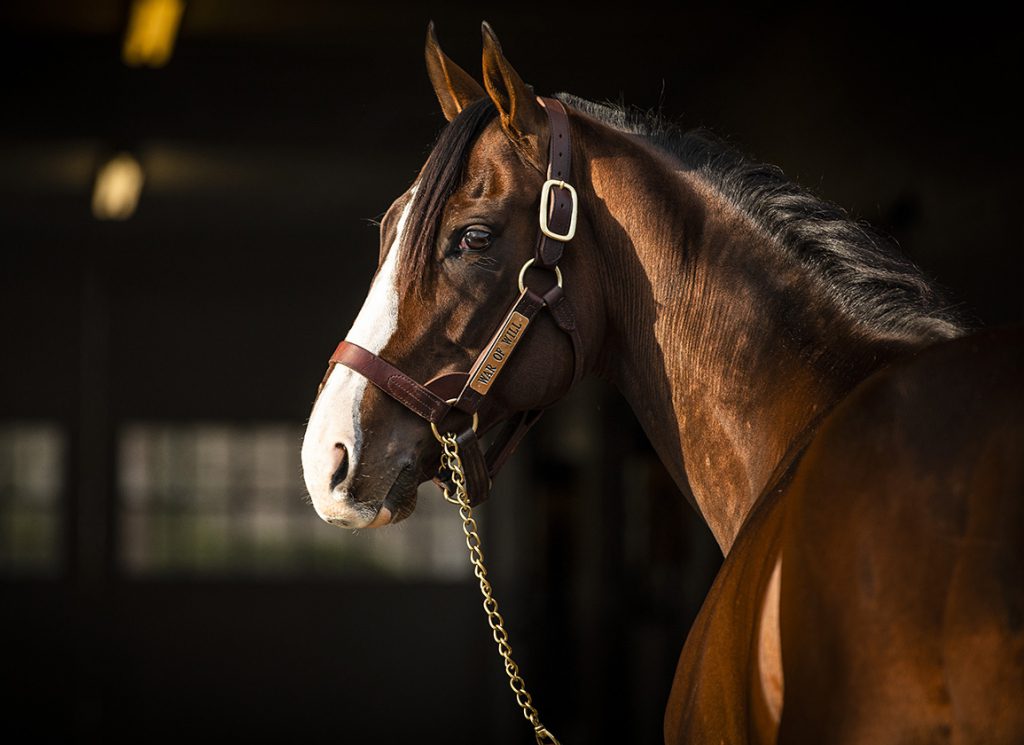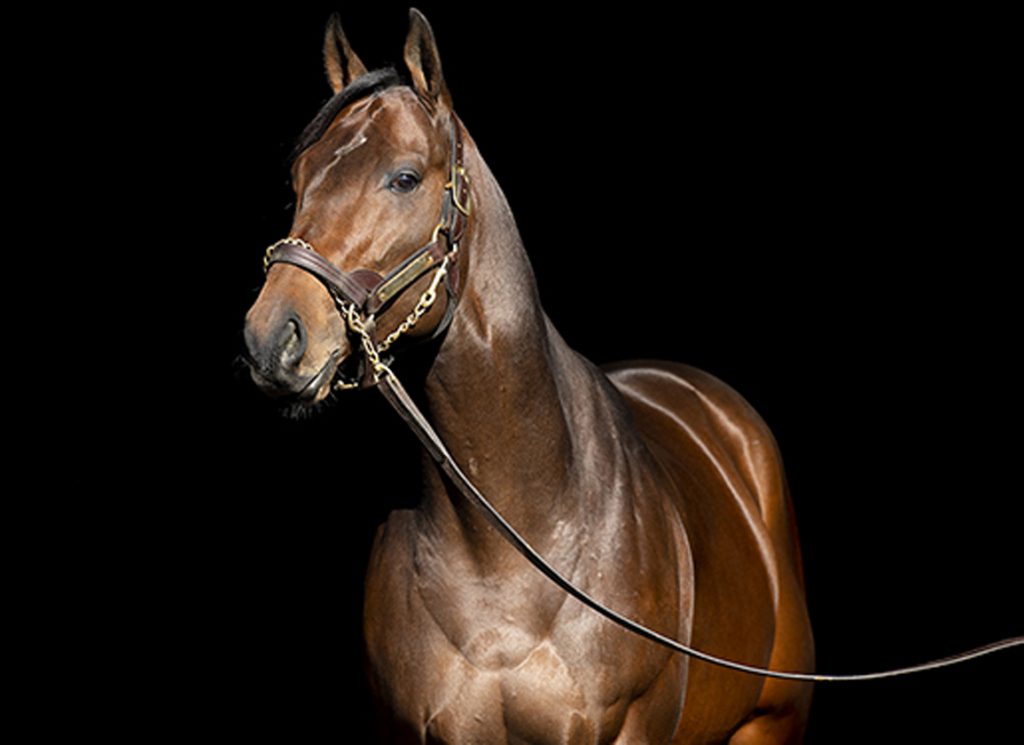Having dealt with the new sires as a case apart, today we start our journey through the price bands of Kentucky stallions by seeing what we can do with a four-figure budget.
Even at this end of the market, the perennial dilemma remains that value means different things to different people. A breeder operating at this level tends to appreciate every cent of a commercial return, however marginal. If your belt is already at the last notch, then the understandable inclination is to leave any selfless consideration of the breed's wider interests to those who can better afford it. Nonetheless I would persist in the view that anyone who believes in a mare can do her no better service than try to put a winner on the page.
Many stallions in this bracket are barely clinging to a place in the Bluegrass, even though in many cases they have had little or no opportunity to show what their mature stock can do on the racetrack. We know that the commercial compulsion towards new sires is double-edged, in that they are abandoned just as promptly as they were embraced only a year previously. And once a sire is reckless enough actually to start testing his genetic prowess by fielding runners, the game really is up for most.
Even the few that make a good start on the track tend to find their books and sales yield both on the slide. As a result, the types that are entitled to need a little more time tend to find themselves almost wholly abandoned. If you're keeping the faith with your stallion, all you can do is stand him at this kind of fairly token fee pending the testimonials of the winner's circle. The trouble is that even an excellent ratio of track success, when your volume is so low, will be submerged by “yet another stakes winner” advertised for rivals who may have 500 more foals on the ground across their first three crops.
The trick, among the younger sires, is to distinguish between those lurking at this level only pending a breakout, and those who are merely clinging to hang on. Because we must never forget that Into Mischief himself once spent a couple of years languishing at $7,500.
An alternative source of value at this level is a handful of stalwarts who have quietly carved out a respectable niche of service for breeders of modest means and realistic ambitions; plus a few younger ones who appear on course for that kind of yeoman viability.
Take TAPITURE, for instance. He was launched with plenty of volume: in fact, in his intake only American Pharoah has more named foals. Granted that the quality clearly couldn't match the quantity, at this level, his ratios will probably never be very startling. But he has shown himself able to get plenty of black-type action with an adequate mare and, while Repo Rocks this year became only his second domestic graded stakes winner, his 111 Beyer in blitzing the GIII Toboggan S. and a runner-up finish in the GI Carter together complement the Classic-placed Jesus' Team as evidence that someday Tapiture is going to land an elite score at just $7,500.
At the same fee, his farm has not managed to muster anything like the same demand for COUNTRY HOUSE, who had to make do with just 119 mares across his first three books and endured corresponding inattention for his first yearlings. But he did sell one for $250,000, and I hope he can similarly defy the odds once he gets a foothold on the track over the next couple of years. His inherent merit was lost in all the blather about the horse he supplanted in the Derby, but his performance there was absolutely consistent with the progress he'd been making and it was terribly unfortunate that he never had the chance to corroborate his breakout–especially after the gamble of trying again the following year left him even more of a forgotten horse. It's ridiculous that so many of those that finished behind him at Churchill were launched with huge books at much higher fees. Country House's sire was always scandalously underrated, but he's inbred to the Sam-Son matriarch No Class (Nodouble) and could certainly breed a horse capable of attending to his unfinished business with the Derby.

Country House | Matt Goins
Darby Dan is definitely worth a visit for those working to this kind of budget, then, as a look at our podium will confirm, and the same is true of Airdrie. True, a couple of that farm's most attractive options demand a little nerve, in that they must negotiate the tricky chicane between small books and the maturity of their first stock, but both are now a bet to virtually nothing at $5,000.
Nobody could have expected PRESERVATIONIST to set the world on fire overnight, having won his Grade I at six, but he's had 13 juvenile winners already from 41 starters-a ratio that matches or beats many peers working from monster books. Unsurprisingly, in the world we live in, his second crop were quiet at the sales but earlier transactions of $280,000, $260,000 and $250,000 show the kind of stamp of horse he can produce. And there are few stallions in any bracket with a better shape to their pedigree, with King Ranch queens Courtly Dee and Too Chic standing opposite each other. I'd be amazed if Preservationist doesn't make a broodmare sire.
DIVISIDERO was never going to cause a stampede, either, having been so recklessly “uncommercial” as to advertise his constitution on the racetrack until the age of seven. He duly had a small debut crop, prompting little interest at the yearling sales, but from this tiny foothold he has mustered a very talented horse in Vote No, whose three starts to date comprise maiden/stakes/length defeat in a Grade II. He had a good winner at Gulfstream just last week, too, leaving him top of the freshmen table by earnings per starter. In the meantime, the eight yearlings sold from his second crop, again very small, included a colt and filly that each made six figures at the September Sale.
So Divisidero is hinting, to those who pay heed, that he could yet claim a role in filling the void left by the loss of his sire Kitten's Joy. Remember that his two GI Woodford Reserve Turf Classics, 13 triple-digit Beyers and length defeat in the GI Breeders' Cup Mile have a genetic bedrock in none other than Cosmah as fifth dam.
The crass neglect of turf sires also requires us to draw attention to DEMARCHELIER (GB) at $7,500. His unfortunate derailment, after an immaculate start to his career, required Bluegrass breeders to show uncharacteristic breadth of perspective by grasping their good fortune in having access not only to a son of the European great Dubawi (Ire) but also to an outstanding Classic family. Demarchelier's first crop will not come fully into their own until stretching out at three, but a perfectly respectable start by his American juveniles is not even half the story, with a youngster Group-placed in France from a handful of starters over there.
His veteran neighbor at Claiborne, FIRST SAMURAI, is a seriously productive horse to be standing at the same fee. He's actually inside the top 20 active stallions on lifetime earnings, and it's very scrupulous of the farm to advertise only six millionaires when he also has one who came up cents short at $999,000! That's not enough for the typical breeder, apparently, as he's only getting small books nowadays. But if you want to put a winner under your mare, here's a Hopeful/Champagne winner by Giant's Causeway for a fraction of the price required to reach many horses of less accomplishment who have yet to sire the winner of a maiden claimer.
TOM'S D'ETAT won't have a runner himself until next year yet has somehow just suffered a third consecutive fee cut, from an opening $17,500 to $7,500. That reflects the modest commercial traction of his first yearlings, but on the racetrack he achieved a high level with maturity-nine consecutive triple-digit Beyers-and he's by a sire of sires out of Giant's Causeway mare whose own mother was a sister to Candy Ride (Arg). Tom's D'Etat has every right to sire runners at a fee that minimises those risks equally attached to more expensive but similarly unproven horses.
That said, there's no denying the superior impression made by the first yearlings presented by CARACARO. They were processed at an average of $41,745 from a base of just $6,500, thanks partly to a filly who brought $175,000. In exemplary hands at Crestwood, Caracaro also kept some good company in a light track career and has a physique reminiscent of his expensive sire.
By the way, before we proceed to our Value Podium, don't forget that we surveyed the new sires separately in the first part of this series. That was on the premise that they seldom offer sufficient value, strictly on their merits, to have any chance of a podium against the proven horses in the higher brackets. But that wouldn't apply to a couple we highlighted at this level: the teak-tough and classy SMOOTH LIKE STRAIT is almost insulted by a fee of just $3,500, while LOGGINS actually mounted the top step of the newcomers' podium at $7,500.

Copper Bullet | Matt Goins
VALUE PODIUM
Bronze: COPPER BULLET
More Than Ready ex Allegory (Unbridled's Song)
Darby Dan $7,500
Bronze for Copper? Why not, when this horse has been the medium of a pioneering experiment: not only complimentary covers for mares that satisfied certain selection criteria, but a $5,000 award to their owners once certified in foal!
Nor have their dividends stopped there. The first intimation that the novel strategy was paying off came at the 2-year-old sales, when 11 members of Copper Bullet's debut crop-comprising 34 named foals-achieved the fourth-highest median ($65,000) among new sires, headlined by colts selling at Ocala for $275,000 and $260,000. He then did something even more unusual by actually advancing the yield realised by his second crop of yearlings. At a time when even those of his peers who had made a flying start with their first runners were suffering from the usual slide-so fatuously do purchasers follow the herd-the handful representing his second crop at the sales achieved a median ($55,000) surpassed, among Kentucky sires, only by Omaha Beach.
After another restricted book this spring, Copper Bullet will surely be generating demand after producing Copper Tax to win five off the reel, including two stakes (one by nearly seven lengths), before flattening out from a messy trip in the GII Remsen S. Overall Copper Bullet has had half a dozen winners from 19 starters, including another placed in stakes company.
It all stands to reason, for a four-length winner of the GII Saratoga Special who flashed residual talent at both three and four despite only fitful visits to the track. With a classy French family behind him, his innovative showcasing may turn out to give us plenty more to think about.
Silver: GREATEST HONOUR
Tapit ex Tiffany's Honour (Street Cry {Ire})
Spendthrift $7,500
This farm's system has adapted very well to the upgrading of its roster over recent years but here we have a horse combining a hint of elite caliber at the kind of basement fee that first made the model work. Having duly welcomed 178 mares into his debut book, he's surely going to produce a headliner or two to maintain momentum through the crossroads ahead. As ever, with high volume, you'd want to be taking one of his nicer specimens to market. But plenty of commercial breeders will be happy to accept those terms for such a lenient fee.
On the racetrack Greatest Honour ultimately proved an anti-climax but only after showing ample to suggest that he had inherited a functioning line to one of the great modern families. And at least his fading has brought affordable access to those aristocratic genes, with second and fourth dams both Broodmares of the Year, divided by a GI Kentucky Oaks winner.
Greatest Honour took four starts to break his maiden, but that was fair enough when he was sharing an education with Olympiad, Speaker's Corner and Known Agenda, and he duly beat a subsequent Grade II winner when doing so. Improvement was barely required, then, in making a dazzling emergence on the Derby trail in the GIII Holy Bull S. and GII Fountain of Youth S. He was so strong at the wire in these races that it was a jolt when he could not follow through in the GI Florida Derby, but he disappeared for a year and never really retrieved the thread.
As we've indicated, this horse straddles the divide in that busy Spendthrift covering shed. He's standing at the kind of commercial fee that brings corresponding numbers behind him. But he definitely had a ton of class, far more than his final profile suggests, and recycles genes that could produce any kind. Few stallions at this level will appeal to the breeder who wouldn't mind keeping a filly, but that's a measure of the way Greatest Honour has all bases covered.
Gold: HIGHLY MOTIVATED
Into Mischief ex Strong Incentive (Warrior's Reward)
Airdrie $7,500
I'm going to put it on the line here and declare that this is the value play, hands down, among all the aspiring young sires in Kentucky.
Highly Motivated resides at a farm that strives to price stallions fairly without making breeders pay another way by flooding the catalogues. The 141 mares he covered last year represents a maximum subscription, by its restrained standards, and reflects what a talented runner he was. We'll return to that, but the big news is what has happened to his page since.
If pressed, I suspect that Airdrie might have conceded that the only reason he launched at a fee this low was that it wasn't totally clear that his young dam, albeit a black-type winner in a light career, had much genetic back-up to complement the brilliance we know to expect from Into Mischief. But now look!
Since he went to stud, the two named foals she had delivered since Highly Motivated-only her third and fourth overall-have both emerged as elite performers. The 3-year-old by Flintshire (GB), Surge Capacity, has emerged from nowhere to be beaten by a single rival in five starts, winning a maiden, two grade IIIs and now the GI Matriarch S. And the 2-year-old filly by Practical Joke produced the debut of the Saratoga meet, geared down by 12¾ lengths for a 90 Beyer, before enduring a horror trip and still failing by only half a length to run down Brightwork (Outwork) in the GI Spinaway S.
Combine those new talents with Highly Motivated himself, and you're looking at a mare entering blue hen territory at the age of 11. Throw in the expensive genes of his sire, and it's hard to resist reminding ourselves that Into Mischief himself once stood at exactly this fee.
A quick refresher: Highly Motivated beat no less a horse than Known Agenda (Curlin) in his maiden before breaking the Keeneland track record in his stakes debut, clocking the second highest juvenile Beyer of his crop. After a messy stakes debut, he probably did himself a disservice in pushing champion Essential Quality so hard in the GII Blue Grass S., just run out of it by a neck, as he left connections no choice but to stretch his speed on the first Saturday in May. His Derby turned into one of those that require an 11-month lay-off, yet he regrouped to claim another track record-one previously held for 37 years by a Horse of the Year-in the GIII Monmouth Cup.
Look, this is a horse with something for everyone. He's a commercial no-brainer, yet benefits from the relative market protection of a commendably restrained farm. And he has just enjoyed a freakish genetic upgrade that creates just as much interest for breeders playing a longer game, as well. Much as had always been true of our silver medallist, Highly Motivated now offers cut-price access to elite blood for anyone who would be happy to retain a filly. Among the four-figure options, no other stallion has this kind of five-star appeal.

Highly Motivated | Sarah Andrew
Value Sires under $10,000: the Breeders Speak
We asked breeders to weigh in on who their top picks were.
George Adams of Housatonic Bloodstock serves as the Director of Stallions and Breeding for Wasabi Ventures.
GOLD: Tapiture (Tapit-Free Spin, by Olympio), Darby Dan Farm, $7,500.
Tapiture would be my best value pick at under $10,000 in Kentucky. For me, value at this price point is about a horse's ability to get runners rather than explicitly commercial considerations, and Tapiture has a high percentage of runners to foals, and an excellent winners/runners ratio. He also has a strong 4.7% stakes winners/foals aged 3 and up. His 11.3% stakes horses/foals is solid as well. Plus he can get you a two-year-old, which we all like to have. He has 25 juvenile winners already in 2023, with a pair of black-type winners and five more that are stakes-placed. To me, that makes him very good value and an excellent choice with which to start off a young mare–especially since his physical makes him easy to breed to.
SILVER: Demarchelier (GB) (Dubawi {Ire})-Loveisallyouneed (Ire), by Sadler's Wells), Claiborne Farm, $7,500.
Demarchelier is a really interesting horse at this level. With the start that he's off to with his first crop this year, he has a big chance to make it as one of the next good turf stallions here, I think. His CI shows that he didn't get the best book of mares for these first foals, which isn't unexpected for a two-turn turf horse by Dubawi in Kentucky. But despite his own later-maturing tendencies and that lack of support, he's got double-digit winners to his credit already with far fewer foals than some of the top freshmen. His winners have come in good maiden special weight races, and he has a Group horse in France and a good stakes colt in New York. He's also had some dirt winners, which doesn't hurt his chances. He's a horse that I could see standing for more down the road (and he got a bump for '24), and I think that makes him good value this year.
BRONZE: Instagrand (Into Mischief-Assets of War, by Lawyer Ron), Taylor Made Stallions, $7,500.
Typically I have a hard time calling an unproven stallion a good “value” just because I think that it has to be a function of their ability to get runners. But in the case of Instagrand, who will have his first two-year-olds next year, I think he's got so many things going for him that he counts as value this coming spring. He was the first seven-figure sales son of Into Mischief, and he was so precocious–which you can easily see why by looking at him–I have a hard time believing that he's not going to be giving Authentic a run for his money at the top of the freshman sire list next year. At 190 mares bred in that first year, he'll have plenty of ammunition, and we all know the quality of some of the mares that Larry Best sent to him, which will set him apart from some of the others at this prince point. His first crop have sold well, and the ones that I have seen have looked quick and early. So when they come out firing early next year and put Instagrand right at the top of the freshman sire list, I think that'll make his '24 fee look like pretty good value.
Andrew Cary, Cary Bloodstock
Gold: Loggins (Ghostzapper-Beyond Blame, by Blame), Hill 'n' Dale Farms, $7,500.
Excellent physical, high-level talent, and the pedigree to succeed. He was a pricey Saratoga yearling and ran to his looks. Beaten a nose by champion Forte in a Grade I and looks like a slam dunk under $10k as a first year sire with big upside. Hill 'n' Dale has an excellent reputation developing stallions with his profile such as Army Mule and Maclean's Music.
Silver: Instagrand
Into Mischief has already sired the likes of Practical Joke, Maximus Mischief, and Goldencents and his reputation as a sire of sires will only grow in the future. Instagrand was a precocious and brilliant 2-year-old and he should have lots of early runners next summer with his first crop. His first crop of yearlings averaged over $44k this year.
Bronze: Beau Liam (Liam's Map-Belle of Perintown, by Denere), Airdrie Stud, $6,000.
He had elite talent and his first few races were jaw-dropping. Another beautiful physical, he has all the ingredients to succeed and has been well supported for an under $10k sire. His first foals look the part and were well-received at the November sales.
The post Value Sires For 2024–Part II: Stallions Under $10,000 appeared first on TDN | Thoroughbred Daily News | Horse Racing News, Results and Video | Thoroughbred Breeding and Auctions.




